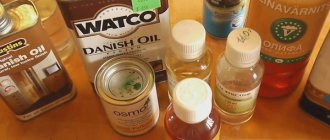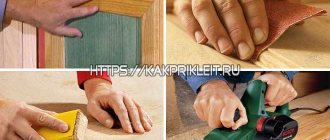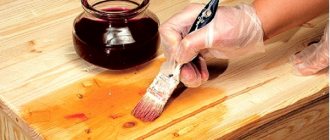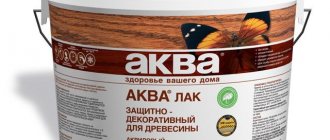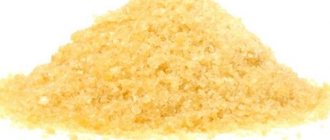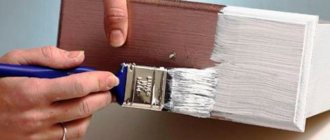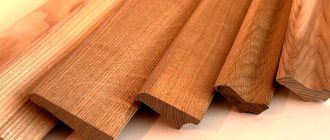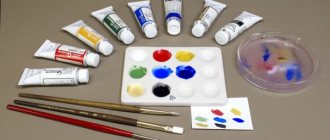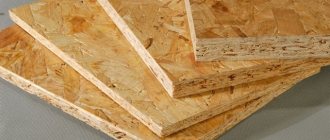PREPARATION OF Drying oils and varnishes
Natural drying oils are certain vegetable oils that have been properly processed.
They are used in the production of oil paints, primers, etc. When applied to the surface and dried, drying oils form a well-adhering and water-insoluble film. In addition to natural drying oils, our industry produces a number of substitutes (oxol, sulfoxol, etc.), as well as surrogate (chemical) drying oils with mineral oils. To prepare high-quality drying oil, mainly linseed, hemp, sunflower and other vegetable drying oils and siccatives (drying agents) are used - special substances that are introduced into the processed oil in order to dehydrate it and increase its drying ability. The best quality drying oils are made by blowing air through heated oil and then adding a drying agent.
Previously, only metal oxides and various salts of inorganic acids were used as driers, for example, litharge, red lead, manganese peroxide, boron-manganese salt, etc.
Where is drying oil used?
What is drying oil used for? It was originally created to protect building wood from destruction and parasites. In addition, drying oil made from linseed oil or other vegetable oil is used in the process:
- Applications before painting on wooden and metal surfaces. Coating with polymer drying oil promotes better adhesion of paints and varnishes, and, in addition, by reducing penetration into the wood structure, reduces their consumption;
- Production of coloring compositions. For oil paint, an alkyd composition is often used as a less expensive ingredient. Synthetic impregnation is not used in the paint manufacturing process due to low quality;
- Dilutions of thickly rubbed paints. This helps make them more elastic and increase volume.
Coating with polymer drying oil promotes better adhesion of paints and varnishes.
How to cook drying oil at home?
Recently, driers, which are salts of organic acids, have become very popular. These dryers include: linoleates - salts of linseed butyric acid and resinates - salts of the acids that make up rosin (linoleates and resinates are sold in pieces). There are also liquid driers on sale, which are a solution of driers in turpentine, gasoline or linseed oil.
There are two ways to prepare drying oils: hot and cold. The hot method involves cooking the oil at a temperature of 200–280°. With the cold method, heating is carried out to 120–150°.
How to make linseed oil?
Drying oil (oil) is often used during finishing work as a primer or paint thinner. If for some reason you don’t have factory-made drying oil on hand, you can make this product yourself at home. This product is made from vegetable fat, usually flaxseed or sunflower oil.
Linseed oil drying oil
To make linseed oil you will need the following equipment:
- metal utensils (basin, ladle, plate, pan, etc.);
- heating device (kerosene stove, gas or electric stove);
- rosin;
- manganese peroxide;
- respirator and gloves.
Pour oil into a vessel and heat over low heat. Upon reaching 110 degrees, the oil will begin to release water - this will be noticeable to the eye. Next, the process of water evaporation begins. In this case, you need to ensure that the temperature of the liquid does not cross the line of 160 degrees. The oil should be boiled for 4 hours.
Note! Drying oil is a fire hazard, so do not pour too much oil into the container. It is enough to fill half the vessel.
After the water has evaporated and foam has formed, you can add a drier based on the following proportion: 30-40 grams of the substance per liter of oil. When adding a drier, a lot of foaming occurs, so the work must be done with extreme caution, adding the substance gradually.
When the drier is added, increase the temperature to 200 degrees and continue to cook the mixture for 3 hours. The readiness of the composition is checked as follows: a drop of the substance is placed on the glass, and if it is transparent, the solution is ready. Next, the composition is cooled at room temperature.
A drier is an auxiliary substance that affects the drying speed of drying oil. This component is included in oil paints, where it is responsible for the same property.
To make a drier, you need to mix rosin with manganese peroxide based on a ratio of 20 to 1. First, bring 20 parts of rosin to a state of melting at a temperature of 150 degrees above zero, and then add 1 part of manganese peroxide.
Drying oil from sunflower oil
A composition made from sunflower oil will protect the surface just as reliably as one made from linseed oil. The only difference is that the color of the product will be lighter, which can be used, for example, for the design of a room.
You can prepare drying oil in two ways - hot and cold. Hot cooking allows you to obtain particularly durable coatings on the surface being treated.
Whatever method of preparing the composition is chosen, the oil still needs to be processed thermally. When making drying oil, it is necessary to remove water from the composition, as well as oxidize all kinds of impurities.
Instructions for heat treatment of sunflower oil:
- Pour oil into a metal container. The oil should fill the dishes no more than 50-60%. Place the container on low heat.
- After the oil reaches a temperature of 110 degrees, abundant foaming and evaporation of water begins.
- Increase the temperature to 170 degrees and keep the oil on the fire for another 3-5 hours.
- After the water has completely evaporated, raise the temperature to 250-280 degrees. At this point, darkish flakes will begin to separate from the oil.
- Let the oil cool at room temperature, and then strain it through cheesecloth. The process of preparing the base for drying oil is complete.
Tip #1: You can determine whether the oil has heated to a temperature of 250-280 degrees using a goose feather. If the edges of the feather curl or deform, it means that the desired temperature has been reached.
Tip #2: to reduce foaming, it is recommended to add a little prepared drying oil at room temperature to a metal container.
Recipe for preparing the mixture using the cold method:
- Heat the prepared base to 120-150 degrees. In this case, the base must be constantly stirred.
- As soon as the desired temperature is reached, add a drier - its share in the oil solution should be 5-8%. For greater safety, it is recommended to first mix the drier with the same amount of oil, and only then add the mixture to the base. If, nevertheless, the foam is released very intensively, we reduce the rate of addition of the drier and vigorously mix the mass.
- After combining all the components, remove the container from the heat and cool the drying oil at room temperature.
Recipe for preparing the composition using the hot method:
- Heat the base to 170 degrees and add a drier at the rate of 1.5-2.5% of the volume of the base.
- Before adding the drier, mix it with dehydrated sunflower oil in equal quantities.
- As soon as foaming has decreased, we begin to increase the heating temperature to 280 degrees. At the same time, regularly stir the composition throughout the entire cooking process (about 4 hours).
Impregnation with drying oil
Methods for impregnating a wooden product:
- Treating wood with hot solution. Soaking is carried out in a water bath. This method is good for processing small parts. Place the wooden product in a bowl with hot drying oil for 4-8 hours. Then we wait for 4-6 days for the surface to dry completely. Please note: if you mix red lead (3-4% of the total volume) with drying oil, the quality of impregnation will significantly increase, and the surface will dry in just 2-3 days.
- Treatment with a solution of oil and kerosene. We combine the components in a ratio of 1 to 1. It is acceptable to use both cold and heated ingredients. However, the temperature of the solution will affect the speed of impregnation: the surface needs to be treated with hot drying oil for only 3 hours, but if the composition is cold, it will take 1-2 days.
- Treatment with a solution of oil, paraffin and turpentine. To prepare the solution you will need 40% drying oil, 8% turpentine and 52% paraffin. First, dissolve the paraffin using turpentine in a water bath. Then add drying oil and mix the mixture thoroughly. Apply the hot solution to the wood. The drying period will be from 2 to 3 days.
- Treatment with a solution of oil and wax. The solution is prepared based on the following proportions: 85% drying oil, 15% wax. Grind the wax and immerse it in the hot mixture. The drying time for the surface will be within 2-3 days.
Drying is a responsible job that does not end after treating the surface with drying oil. Before continuing to manipulate the wood, you need to wait until the coating is completely dry. The drying rate depends on several circumstances, including: the components of the solution used, the amount of drier, the type of wood and other factors.
Drying oils with driers based on polymetals dry the fastest. But monometallic driers do not promote rapid drying. For example, a surface treated with drying oil with lead drier will dry in 20 hours.
If lead is replaced with manganese, drying time will be reduced to 12 hours. An even better drying performance is achieved by combining lead and manganese into a polymetallic drier. In this case, the surface will dry in 7-8 hours.
Air humidity and temperature have a significant impact on drying speed. Drying oil with cobalt drying agent will dry 1.5 times faster when the air temperature rises to 25 degrees.
Under the same conditions, a solution with manganese drier dries 4 times faster. The optimal air humidity for drying the surface is 65-70%.
Drying oil substitute
This option is for those cases when it is not possible not only to purchase factory-made drying oil, but also to make it yourself at home.
Substitute recipe:
- casein - 50%;
- slaked lime - 25%;
- turpentine - 12.5%;
- soap solution - 7.5%.
Add turpentine after thoroughly mixing the other ingredients. Next, dilute the mixture with water until the solution looks like thick drying oil. To avoid the appearance of sediment, add a little ammonia to the composition.
A surface treated with casein solution dries faster than with drying oil. The composition can be added to oil paints to improve their strength and water-repellent characteristics.
See also:
- Pumping stations
- The water in the septic tank is frozen: what to do?
- What is the concrete mixture made of?
- Installation of water supply systems
- Concrete mixture manufacturing technology
- How does a septic tank for a summer house work?
chudoogorod.ru
Linseed oil drying oil
Drying oil must be cooked with great care, as it can ignite and cause a fire. You can cook drying oil in any metal container on a primus stove, stove, or kerosene stove.
The vessel is filled with oil, no more than its volume. First, when heated, water is released. At a temperature of 110–120°, complete evaporation occurs. This creates foam, especially when using fresh oils, so the temperature should be raised slowly and not higher than 170°. This often takes from 3 to 5 hours.
When there is no foam, add siccative to the oil in small portions. For 10 kg of oil, 300–450 g are required. With each addition of drier, the oil begins to foam, so it must be introduced carefully. The oil is heated for some more time and then cooled.
Drying oil prepared with a drying agent from a mixture of manganese oxide, zinc and calcium dries faster. A good linseed oil should dry within 8-12 hours.
Types of drying oil
There are three types of drying oils: oil, alkyd and composite. Butter is made by heating oil and adding metal compounds to it.
There are 3 types of oil drying oil:
- Natural. This is an almost transparent dark or light (depending on the raw material used) oily liquid with a slight aroma of the main ingredient. In accordance with GOST 7931-76, this type of drying oil consists of 97% hemp or flax oil. The remaining 3% are driers. The drying oil dries within 24 hours. The composition of natural drying oil is recognized as safe, therefore it is used for drying wood finishing inside buildings;
- Oxol. According to GOST 190-78, the oxol contains any type of vegetable oil (55%), solvent (40%) and drier (5%). When producing oxol, partial replacement of oil (up to 40%) with petroleum polymers is allowed. Drying oil for paint, combined oxol, has a specific odor, which is explained by the presence of a solvent in it - white spirit, gum turpentine, nefras;
- Combined. In general, such drying oil is almost identical to oxol and differs only in the percentage of substances: there is more oil and less solvent.
To produce alkyd impregnation, alkyd resins, driers and solvents are used. Composite (or synthetic) drying oil is considered the cheapest. What it is? It does not contain natural oils or resins. Instead, synthetic substitutes are used, usually petroleum products.
Synthetic drying oil has a darker color and a specific odor. The quality is also not impressive - some synthetic compounds take a very long time to dry, others, when dry, form a crumbling glass-like film, others do not dry at all, and paint does not adhere to the materials they have treated. Synthetic impregnations include polydiene, ethinol, synthol and slate impregnations. This type is not suitable for work inside buildings.
It is intended for:
- Drying of concrete pavements;
- Renewal and consolidation of old paint and varnish coatings;
- Preparation of mastics;
- Thinning dark paints and varnishes.
Synthetic drying oil has a darker color and a specific odor.
Drying oil from sunflower oil
Sunflower oil has less drying ability than linseed oil, and drying oil cooked with it is inferior in quality to linseed oil.
Sunflower oil must be gradually heated to 280°, at this temperature quite thick brown flakes appear floating in the oil. Then the heating is stopped, the oil is allowed to cool, after which it is filtered through a felt filter or gauze folded in several layers. A siccative is added to the filtered boiled oil.
Drying oil from sunflower oil can also be prepared in a cold way, that is, by heating the oil to 120–150°, but in this case the drying ability of the drying oil will be slightly lower. To 100 parts of boiled oil add 2 parts of a drier - manganese linoleate or manganese resinate. Drying oil dries completely on wood in 30–35 hours, on glass in 13 hours.
How to prepare drying oil
Drying oil can be freely purchased at a hardware store. But the huge selection is often misleading and leaves you guessing which product is of better quality. Using simple instructions, you can make drying oil with your own hands in your own kitchen. In this case, you will be confident in the naturalness of all the ingredients, and therefore in the quality of the drying oil itself.
Linseed oil drying oil
Previously, drying oil was made by cooking and exclusively linseed oil was used for this.
To prepare classic drying oil you will need:
• any metal vessel (plate, basin, ladle, pan);
• heating device (kerosene stove, gas or electric stove);
• linseed oil;
• rosin;
• manganese peroxide;
• gloves;
• respirator.
When preparing linseed oil, remember that the oil can ignite, so do not pour too much of it - 3/6 of the total volume is enough.
Pour oil into an iron container and heat over low heat. First you will see how the oil has released water. This happens when its temperature has not reached 110 degrees. After this, the water begins to evaporate. Make sure that the heating temperature does not exceed 160 degrees.
Flaxseed oil should be simmered over low heat at a temperature no higher than 160C for about 4 hours. When all the water has evaporated and foam stops forming, you can add a drier at the rate of 30-40 g/1 liter of oil. When introducing a drier, a lot of foam is formed, so this must be done as slowly and carefully as possible. After this, cook the mixture for several minutes over low heat and leave to cool at room temperature.
Drying agent or manganese resinate is a special auxiliary substance that promotes rapid drying of drying oil. It is also present in oil paints, performing the same function.
To prepare a drier, you need to mix rosin and manganese peroxide at a ratio of 100:5. First, 100 parts of rosin must be melted in a separate container at 150C, then gradually add 5 parts of manganese peroxide. Please note that the mixture will foam a lot, so each part of manganese should be added as the foam decreases. When all ingredients are mixed, increase temperature to 200C and cook for 3 hours. You can check the readiness of the drier by dropping it on the glass - if the drop is transparent, the process is complete.
Drying oil from sunflower oil
This drying oil is an excellent and widely available alternative to the flaxseed recipe. Just like natural wood, it leaves an elastic, durable film on the surface and perfectly protects the wood. The only thing is that the color of sunflower drying oil will be much lighter. This can be used for design tricks when creating a cozy interior. You can prepare such drying oil using two methods – cold and hot. In the second option, the film on wood is especially durable.
Regardless of the preparation method, sunflower oil must be heat treated. The removal of water from oil and the oxidation of impurities in its composition are an integral part of the process of cooking drying oil.
- Fill an iron container with oil to 3/5 of its volume and place on low heat.
- When the temperature reaches 110-120 degrees, foaming and dehydration will begin.
- Heat the oil, maintaining the temperature to 170 degrees for 3-5 hours.
- When the water has completely evaporated, increase the temperature to 280C. It will become visible how distinct dark flakes stand out from it.
- Cool the oil and strain through a filter (gauze, felt). The base for preparing drying oil is ready.
Helpful tip: to check if the oil has warmed up to 260-280C, dip a goose or pigeon feather into it. If the edges curl and shrink, you have reached the desired temperature. To “tame” the abundantly protruding foam, pour a little prepared cold drying oil into an iron container.
- The cold method is to heat the oil base to 120-150C and, stirring continuously, add a drier at the rate of 5-8% of the oil volume. To make the process as safe as possible, it is first better to mix the drier with an equal amount of the oil base, and only then add it to the main mass. If the foam is released too abundantly, reduce the speed of introduction of the drier and increase stirring. When the ingredients are combined, turn off the heat and cool the drying oil at room temperature.
- The hot method is to heat the oil base to 170C and carefully introduce the drier into it at the rate of 1.5-2% of the total mass. The drier must first be ground with an equal amount of dehydrated sunflower oil. When all the drier has been added and no more foam is released, heat the mixture to 280C. Continuously stirring the future drying oil, maintain the cooking temperature for about 4 hours until the desired degree of viscosity is obtained.
Preparation of driers
Manganese resinate - 100 wt. parts of rosin are melted at a temperature of 150° and 5 parts of manganese peroxide are added in small portions; At the same time, the mass foams strongly. Each subsequent portion of manganese peroxide must be added after the foam from the previous addition begins to subside. Then cook the mixture at a temperature of 190–200° for 3–4 hours. When the sample on the glass is transparent, the drier is considered ready.
Lead resinate is obtained using the same method, but taken at 100 weight. rosin infusion 10 parts of lead litharge.
Celluloid varnish from old photographic films
Celluloid……………….…40 g
Amylacetate……………….500 ml
Acetone…………………….500 g
Celluloid varnish can be made from old photographic films. The films must first be freed from the negative layer, for which they are soaked in a hot soda solution. After removing the negative layer and washing in warm water, the celluloid is dried in air. Celluloid cut into small pieces is processed in a wide-neck bottle with a mixture of acetone and amyl acetate. The bottle is carefully corked and shaken from time to time. Dissolution occurs relatively slowly. After allowing the liquid to settle after dissolving, carefully pour the clear liquid into another bottle. Instead of photographic films, you can use celluloid in any form to make this varnish.
Water-based varnishes
Water-based varnishes are used for varnishing furniture, leather, wallpaper and other items. The preparation of water-based varnishes is carried out as follows. In an enamel pan, heat water to a boil and add alkali or alkali salts (ammonia, borax, goda). After the alkali has dissolved, shellac is added in small portions. Subsequent portions of shellac are added only after the previous portion has dissolved. The solution is cooled. Shellac wax that floats to the surface is removed by filtration. While preparing the varnish, you can add water to replace the boiling water.
How can I replace drying oil?
If it is not possible to buy or prepare natural drying oil, you can replace it with a product that will protect the tree no worse.
Mix casein with soap solution and slaked lime:
- casein – 100 parts;
- soap solution – 10-15 parts;
- slaked lime – 20-50 parts.
Mix the ingredients thoroughly and gradually add turpentine (25-35 parts). Dilute with water to the consistency of regular thick drying oil. Casein lime may precipitate, but this can be avoided by adding a small amount of ammonia.
This solution is much cheaper than GOST drying oil from any store. However, he can successfully replace it in all respects. It dries much faster than drying oil. It can also be mixed with oil paint for interior and exterior decoration. Resistance to water and mechanical shock makes it an excellent alternative to natural drying oil. In addition, the composition adheres well to metal products, giving them shine and protecting them from scratches.
Varnishes and polishes for furniture polishing
1) Gasoline…………………………..500 g
Flaxseed oil (boiled)………….56 g
Cedar oil…………………28 g
Mix and use with a soft sponge or cloth. Rub until shiny after 30 minutes.
2) Stearin………100 g
Turpentine……….140 g
Dissolve stearin in heated turpentine and allow to cool. A small amount of this ointment is applied to a piece of wool and polished.
Cooking old drying oil
In order to return the substance to the necessary viscosity and properties, it is recommended to heat treat the old version of the composition. Especially for this purpose, provision is made for preparing the container and then pouring in the solution. Next, you need to add a small amount of drying agent, while regularly stirring the drying oil so that it does not turn out to be too thick. During the cooking process, the temperature is maintained around 150-170 degrees. The whole procedure lasts up to 2 hours, and the composition should be constantly stirred. Finally, you need to let the ingredient cool before using it directly.
1 / 5 ( 1 voice )
Durable, fast drying benzene varnish
Benzene………………………..1 kg
Rosin………………………400 g
Coal tar pitch……….900 g
Crushed rosin is dissolved in benzene when heated in a water bath at a temperature not exceeding 70°. Crushed pitch is added to the resulting solution. After stirring for an hour, the solution is cooled. The finished varnish is allowed to settle, after which the clear solution is drained from the settled sediment. The varnish can be used for coating metals, wood, and leather.
Fixatives
In order for drawings made with pencil, charcoal or chalk to become indelible and indelible, they are treated with a fixative of the following composition:
Casein powder…………….50 g
Ammonium carbonate………….75 g
Wine alcohol………………..800 cm3
Water……………………………2.5 l
Dissolve ammonium carbonate in water and add pure breech powder. Shake the mixture well and place in a warm place. Shake the liquid occasionally until the casein dissolves. The liquid takes on a yellowish-turbid color. Then pour alcohol into it little by little, shaking vigorously. You need to add alcohol carefully so that casein does not separate out in the form of flakes. During storage, the fixative usually produces a sediment; You need to drink clean liquid, trying not to stir up the sediment. The fixative is applied to the picture (drawing) using a spray gun.
